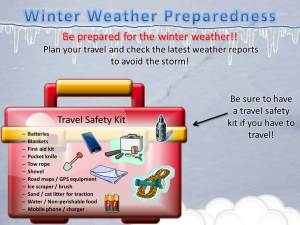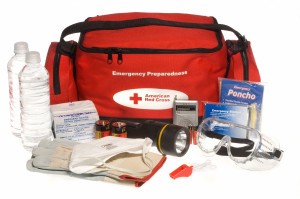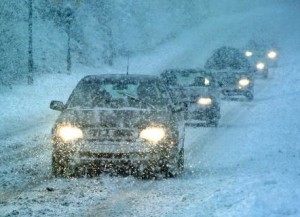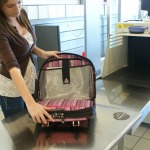Traveling in Not-So-Cheery Weather

I’m sure several of us can agree that hazardous weather was an issue when commuting to competitions this past winter. Mother Nature had her hair piece in a little too tight last cheer season, and it led to dangerous road conditions and even a few teams were forced to pull out of a competition altogether. As we are well aware, the majority of competition companies hold the competitions regardless of inclement weather, so if your gym chooses to brave the conditions, here are some important things to keep in mind.
#1 First and foremost, SAFETY is the number one priority. If you feel you are putting your child and/or your family’s lives in danger please do not risk it!
Here are some tips to prepare if you are traveling in less than cheery weather conditions.
• Use the buddy system. Travel with another cheer family. If you do become stranded, having extra people will increase your chances of being able to get help and get to safety.
• To add to the above, if you are nervous driving on snowy roads, please ride with someone who has experience and can keep their calm on less than ideal road conditions.
• Keep electronics fully charged. Cell phones should be charged. Any other method of communication (ipad, laptop, etc) make sure it is charged prior to leaving.
• List of coaches phone numbers, a few parent phone numbers, phone number for the venue, and all ICE contacts updated in your phone.
• Allow yourself plenty of extra time to reach your destination. It is better to be early and be safe (besides, it gives you extra time to hit Starbucks).
• If you have a smart phone, there is an excellent app available by the American Red Cross that provides you with up to date weather alerts for your location.
 Essentials to keep in your vehicle courtesy of NOAA. You can also choose to purchase an emergency kit for your vehicle which will contain many of the items listed below.
Essentials to keep in your vehicle courtesy of NOAA. You can also choose to purchase an emergency kit for your vehicle which will contain many of the items listed below.
• NOAA battery powered radio with extra batteries
• Flashlights with extra batteries
• Blankets and/or sleeping bags and warm clothing
• Booster cables
• First Aid kit
• Bottled water and non-perishable food items
• GPS, road maps. If you have OnStar, make sure your subscription is active and ready for use.
• Shovel, something for traction such as kitty litter, sand, or cardboard
• Flares and an emergency cone/triangle
• Candle with matches
• Red bandana
Winter driving demands an alert driver. Before starting your trip, brush the snow off your vehicle. Remove ice and snow from all glass surfaces and make sure snow has been removed from headlights and tail lights. Other motorists need to be able to see you. Make sure you adjust your driving speed and distances between other vehicles. Most accidents occur when a motorist is driving too fast for existing conditions. Ice and snow demand greater stopping distances. Remember that overpasses and bridges freeze more quickly that other parts of the roadway. If you begin to skid, remain calm, ease your foot off the gas and turn your wheels in the direction you want the front of the car to go. If you have an anti-lock braking system (ABS), apply steady pressure to the brake pedal. Never pump the brakes on an ABS equipped vehicle.
Even the most prepared driver may find themselves stranded in dangerous winter weather. At best, mechanical breakdown, accident or just violent weather can interrupt a winter trip. Panic or lack of preparation can quickly change an interruption to a deadly scene. If you are forced to stop, especially in a remote area, know what to do.
The National Weather Service reports that many people die each year when they attempt to leave their vehicle during a storm. Do not leave your vehicle, in search of help. Your best chance of rescue is to stay with your vehicle. Do not panic. Tie a red bandanna to your automobile antenna as a signal for help. If you are able to start the engine, keep the car running for ten minutes out of each hour, using the heater. Make sure the exhaust is clear, or you could become a victim of carbon monoxide poisoning. Leave a window partially open, as an extra precaution. Keep the interior lights on, while the engine is running, as this provides additional heat. Keep moving your arms and legs, as this will forestall hypothermia.
If your car won’t start, use one of your emergency candles for heat. While a single candle doesn’t sound like a useful heat source, that flame has saved many lives in stranded vehicles. Use your spare dry clothing and sleeping bags for additional warmth. Again, make sure you keep moving your arms and legs to aid circulation. Again, staying with your car is the sensible option. Help will arrive and you will be found.
The best option, if stranded, of course, is to call for assistance by cell phone. Most state police have an emergency number or place a call to 9-1-1. Make sure you give the operator specific information as to your emergency and your location. The more precise you describe your situation, the more quickly appropriate assistance will reach you.
Resources:
www.noaa.gov
http://www.heartofcheer.com/cheerleaders/traveling-cheery-weather/http://www.heartofcheer.com/wp-content/uploads/2014/11/weathertravel3.jpghttp://www.heartofcheer.com/wp-content/uploads/2014/11/weathertravel3-150x150.jpgBlogCheerleadersCoachesParentscheer travel,cheerleading competitions,safety,winter travel





